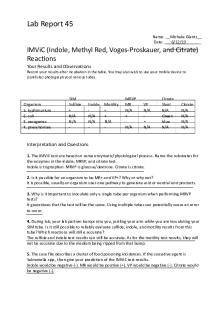Lab Exercise 46 PDF

| Title | Lab Exercise 46 |
|---|---|
| Author | Michele Glantz |
| Course | Microbiology Laboratory |
| Institution | Broward College |
| Pages | 2 |
| File Size | 62.6 KB |
| File Type | |
| Total Downloads | 13 |
| Total Views | 159 |
Summary
Lab exercise typed out...
Description
Lab Report 46 Name: __Michele Glantz__ Date: ___6/13/19_______
Urease Your Results and Observations Record your results after incubation in the table. You may also wish to photograph your tubes.
Organism Proteus vulgaris Excherichia coli
Results (color) Pink Yellow
Does this organism produce Urease? Yes (+) No (-)
Interpretation and Questions 1. Why is it important to limit the available types of nutrients in this broth? Limiting the nutrients to urea as the primary source of carbon ensures that only urease-positive organisms will grow in the medium. 2. The case file gives an example of a digestive system infection caused by a urease-positive organism. What other system or systems could commonly be colonized by urease-positive bacteria? Why? The Urinary System. Urea is a by-product of amino acid catabolism in animals and comprises the principal nitrogenous waste product in urine. 3. Urea broth indirectly identified urease activity by the change in medium pH. How else could urease activity be monitored (consider the case file and the enzyme reaction pathway shown by the equation)? Urease can be monitored using radio-labeled urea, which is then converted into radio-labeled carbon after the organism hydrolyzes the urea. 4. You are testing an unknown organism from an infected patient. Your urease tube shows a slow urease reaction. Additional testing shows that the organism is positive for glucose and lactose fermentation, and negative for indole. Using the table in exercise 49 (49.2), what is the organism? Klebsiella pneumoniae. 5. Consider the case file. Helicobacter pylori metabolizes urea and releases ammonia. How would this affect the microenvironment of the stomach? Is this an important consideration in the treatment of stomach ulcers? Why or why not? H. pylori produces a urease to convert urea from gastric juices as well as saliva into bicarbonate and ammonia—thus, the microenvironment directly surrounding the bacterium is neutralized and the pathogen escapes the corrosive effects of the gastric secretions. Yes if this consideration can be utilized in the way which can stop the bacteria in utilizing the urease, then it would be a breakthrough in controlling ulcers caused by this bacteria.
Lab Report 46...
Similar Free PDFs

Lab Exercise 46
- 2 Pages

Lab Exercise 1 - lab
- 1 Pages

Lab Exercise 1 - Lab work
- 3 Pages

Lab Exercise 2 - lab work
- 3 Pages

Lab 10 Exercise
- 4 Pages

Lab Exercise 44
- 2 Pages

LAB Exercise 5 - practice
- 25 Pages

COMP301Lab05 - Lab Exercise 5
- 2 Pages

Lab 8 Exercise
- 5 Pages

Lab Exercise 16
- 2 Pages

Lab Exercise 29
- 3 Pages

Lab Exercise 23
- 2 Pages

ICT502 Lab Exercise 3
- 6 Pages

Lab Exercise 45
- 1 Pages

Exercise Physiology lab report
- 10 Pages
Popular Institutions
- Tinajero National High School - Annex
- Politeknik Caltex Riau
- Yokohama City University
- SGT University
- University of Al-Qadisiyah
- Divine Word College of Vigan
- Techniek College Rotterdam
- Universidade de Santiago
- Universiti Teknologi MARA Cawangan Johor Kampus Pasir Gudang
- Poltekkes Kemenkes Yogyakarta
- Baguio City National High School
- Colegio san marcos
- preparatoria uno
- Centro de Bachillerato Tecnológico Industrial y de Servicios No. 107
- Dalian Maritime University
- Quang Trung Secondary School
- Colegio Tecnológico en Informática
- Corporación Regional de Educación Superior
- Grupo CEDVA
- Dar Al Uloom University
- Centro de Estudios Preuniversitarios de la Universidad Nacional de Ingeniería
- 上智大学
- Aakash International School, Nuna Majara
- San Felipe Neri Catholic School
- Kang Chiao International School - New Taipei City
- Misamis Occidental National High School
- Institución Educativa Escuela Normal Juan Ladrilleros
- Kolehiyo ng Pantukan
- Batanes State College
- Instituto Continental
- Sekolah Menengah Kejuruan Kesehatan Kaltara (Tarakan)
- Colegio de La Inmaculada Concepcion - Cebu
